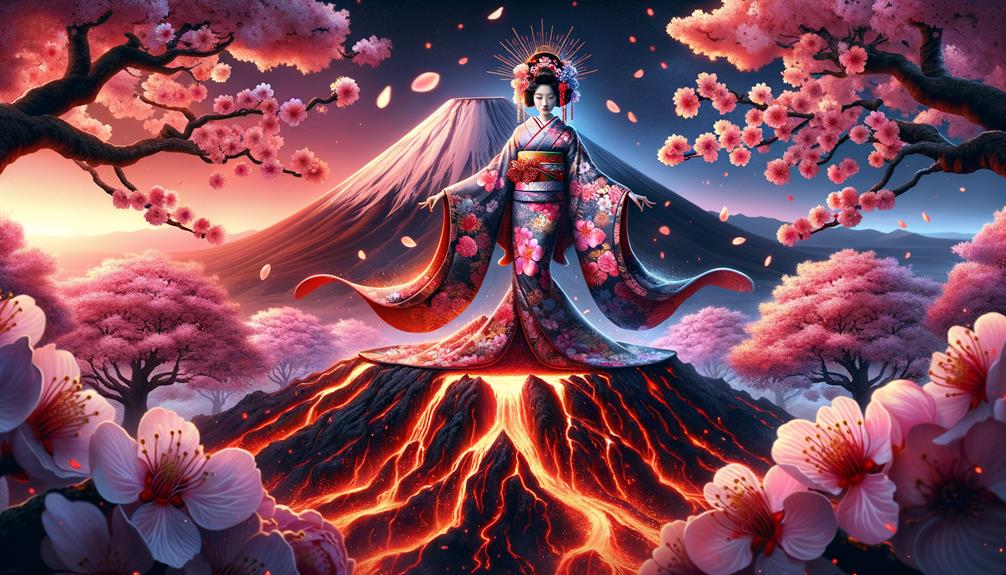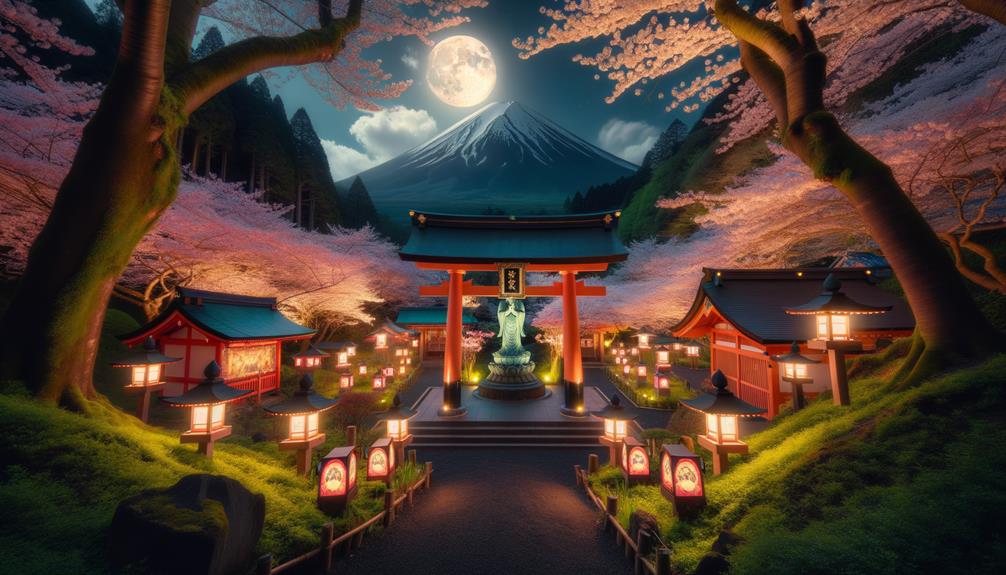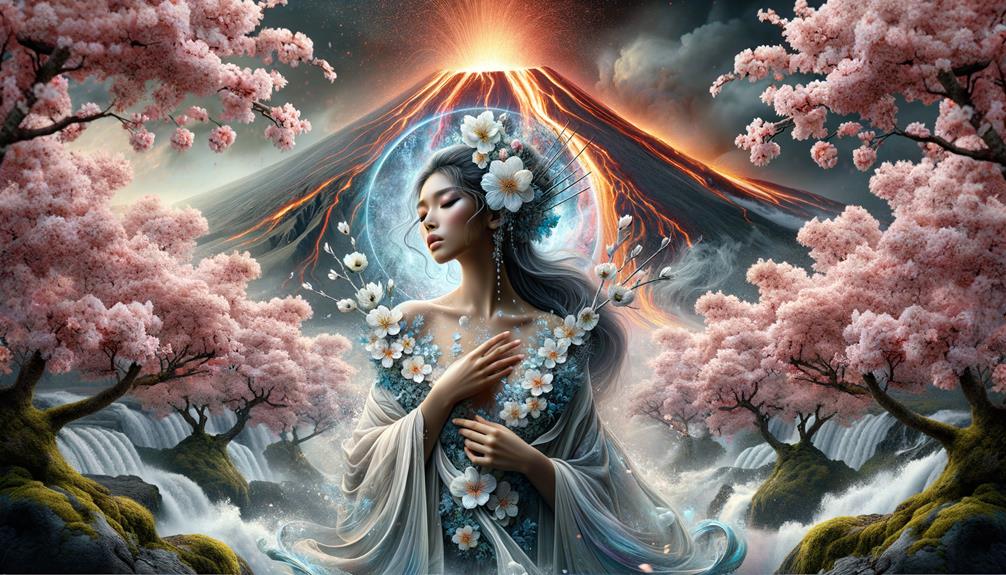Imagine dusk's fiery volcanic glow, signifying destruction and rebirth – that's Konohanasakuyahime, the Volcano Goddess. Her tale intertwines creation and devastation, mirroring the cyclical seasons she oversees. As we explore her union with Ninigi and sacred role in Japanese folklore, her resilience and renewal shine like a phoenix from ashes. Yet her narrative's true strength lies in its modern relevance, echoing through ancient shrines and contemporary stories.
Mythological Origins
In Japan's rich mythological tapestry, Konohanasakuya-hime shines as a radiant figure, embodying nature's powerful and transformative forces. Her story blooms on Mount Fuji's sacred slopes, intertwining with volcanic activity and delicate cherry blossoms. As a volcano goddess, she symbolizes creation and destruction's duality, mirroring nature itself.
Konohanasakuya-hime fell in love with Ninigi, the sun goddess Amaterasu's grandson. Their union wasn't mere romance; it shaped humanity's fate. When Ninigi chose Konohanasakuya-hime, he embraced her connection to the earth's cycles.
Their marriage, celebrated under cherry blossom blooms, brought themes of resilience and renewal. The fleeting yet stunning blossoms echoed her essence—brief but impactful. Through her union with Ninigi, Konohanasakuya-hime's influence extended beyond Mount Fuji, touching upon life's cyclical nature and humanity's enduring spirit.
Symbolism and Representations

Konohanasakuya-hime's symbolism is intertwined with the delicate cherry blossoms, mirroring her beauty and life's transient nature. Her fiery essence evokes resilience and rebirth, akin to a phoenix rising anew. These elements vividly depict a goddess embodying the fleeting and the eternal, a captivating intersection of impermanence and endurance.
Floral Symbolism in Mythology
Cherry blossoms, with their transient bloom and delicate petals, mirror Konohanasakuya-hime's qualities of grace, resilience, and life's impermanence. In Japanese folklore, these exquisite flowers represent the fleeting nature of existence and fresh starts. When the goddess conceived, her story entwined deeply with the cherry blossoms, echoing renewal and impermanence.
As the deity of Mount Fuji, Konohanasakuya-hime shares a profound bond with cherry blossoms. Their brief yet dazzling blooming reflects her journey – graceful and resilient despite adversity. The blossoms remind us that beauty fades, and their yearly cycle of blooming and falling aligns with mythology's theme of life, death, and rebirth. This cyclical nature mirrors the goddess's archetypal role, symbolizing both fragile beauty and enduring strength.
In the hero's tale, Konohanasakuya-hime represents hope and renewal. Her narrative, woven with the cherry blossoms, encourages savoring life's transient moments, appreciating their beauty, and finding strength amid inevitable changes.
Fire and Renewal Iconography
Konohanasakuya-hime's fiery essence, linked to volcanoes, symbolizes both destruction and renewal. Each eruption ravages the land while simultaneously enriching it, reflecting resilience and transformation central to her mythology. Like a hero overcoming trials, the volcanic imagery surrounding Konohanasakuya-hime signifies not just an ending, but fertile new beginnings.
Her connection to volcanoes goes beyond fire and ash; it encapsulates the powerful regeneration that follows. Initially destructive lava flows solidify, creating new landforms and nourishing the soil. This cycle mirrors life, death, and rebirth—a fundamental theme in mythological tales. Konohanasakuya-hime showcases nature's fierce yet nurturing qualities through these processes, teaching that new beginnings arise from the remains of endings, reinforcing the eternal cycle of creation and renewal. Her volcanic symbolism makes her a timeless emblem of resilience and transformative power.
Sacred Shrines

Exploring ancient lands unveiled sacred shrines devoted to Konohanasakuyahime, the goddess revered in volcanic regions. These historic sites, destinations for pilgrims, hosted rituals invoking her blessings for protection and safe childbirth. Each visit unfolded like an epic journey, filled with hopeful prayers.
Historic Pilgrimage Sites
Ancient pilgrims sought solace and divine favor at sacred shrines dedicated to Konohanasakuya-hime on majestic Mount Fuji. The journey mirrored a heroic quest, with devotees ascending volcanic slopes to connect with the goddess embodying both fiery destruction and serene creation.
These shrines, nestled on Mount Fuji, were more than stone and wood structures. They pulsated with divine energy, where seekers implored the goddess for protection from volcanic eruptions and blessings for safe pregnancies and healthy births. Pilgrimage became a transformative rite, uplifting mortals to spiritual fortitude.
The shrines stood as beacons of hope and resilience. Every prayer echoed humanity's timeless plea for harmony with nature. Like ancient heroes, pilgrims emerged transformed, carrying the goddess's blessings to face life's trials. These sacred sites witnessed the divine narrative of Konohanasakuya-hime unfold, offering solace and protection to all devotees.
Ritualistic Ceremonies Performed
In shrines devoted to Konohanasakuya-hime, the rituals resemble sacred dances, inviting the goddess's favor and weaving protective and fertile energies. These ceremonies honor her, seeking blessings for safe childbirth, protection from volcanic eruptions, and overall well-being. Rituals involve prayers, offerings, purifications that cleanse the spirit, and profound reverence for nature.
Worshippers approach these sacred sites like champions embarking on a quest, each step seeking the goddess's divine intervention. They bring rice, sake, and flowers—symbols of life's abundance and gratitude. Through prayers, they connect with Konohanasakuya-hime's protective and fertile energies.
These shrines, sanctuaries of spiritual connection, pulsate with nature's rhythms and the Earth's heartbeat. They remind us of harmony, reverence, and the eternal dance between humanity and nature's forces.
| Ritual Element | Symbolism | Purpose |
|---|---|---|
| Offerings | Life's Bounty | Gratitude and Seeking Blessings |
| Prayers | Divine Link | Aligning with Protective Energies |
| Purifications | Spiritual Clarity | Reverence for Natural Forces |
These rituals embody a profound narrative of seeking and receiving, harmony and protection, echoing timeless heroic journeys.
Stories From the Kojiki

The ancient Kojiki myths captivate with tales like Princess Konohanasakuya's marriage to Hononinigi, igniting Mt. Fuji's flames while embodying human existence's essence. This celestial descendent's union with the volcano goddess symbolizes heavenly and earthly realms converging.
Konohanasakuya's journey echoes resilience, beauty, and life's impermanence. Her fiery childbirth ordeal represents overcoming challenges that forge strength and renewal. Her divine role extends beyond mythology; shrines honoring her provide sanctuaries against volcanic eruptions and blessings for smooth births. Her cyclical story mirrors existence's constant renewal and grace, akin to Mt. Fuji's steadfast, ever-changing nature.
Historic Eruptions

Mount Fuji's eruptions weave a dramatic tale, intertwining natural forces with spiritual narratives like Konohanasakuyahime's legend. The 864 Jōgan eruption, spilling lava and birthing Aokigahara Forest, transformed the landscape, echoing the goddess's creative and destructive power.
In 1707, following an earthquake, the Hōei eruption unleashed a furious Plinian event, casting ash and scoria across vast areas, even reaching Edo. This cycle of upheaval and renewal affirms Konohanasakuyahime's enduring influence.
| Eruption | Impact |
|---|---|
| Jōgan (864) | Lava flows shaped Aokigahara Forest |
| Hōei (1707) | Ash and scoria reached Edo |
| New Fuji (781-1707) | Multiple eruptions during Heian era |
| Gotemba Mud Flow (2300 years ago) | Lahars reached Gotemba, Mishima |
| Post-Hōei | No eruptions since 1707 |
Sixteen eruptions since 781, notably during the Heian era, remind us of Fuji's restless nature. Around 2,300 years ago, the collapse of Fuji's east face triggered the Gotemba mud flow, demonstrating nature's relentless force. These chronicles of fire and ash interweave Konohanasakuyahime's story, embodying the eternal cycle of creation and destruction.
Modern-Day Significance

In today's fast-paced world, Konohanasakuyahime's legend resonates, urging us to appreciate nature's beauty and resilience. At shrines atop Mount Fuji, devotees pray for safe childbirth and protection from eruptions, honoring her timeless grace. Her symbolism, rooted in nature's cycles, offers solace to those weathering life's storms.
Her connection to volcanoes reminds us of nature's raw power and our need for environmental harmony. As we confront ecological crises, her story guides us toward respect and coexistence with our surroundings.
Rituals honoring Konohanasakuyahime allow individuals to embody her qualities – beauty, resilience, and renewal. These practices mirror the hero's journey, where adversity fosters growth and enlightenment.
Konohanasakuyahime's narrative teaches impermanence and resilience's transformative capacity. In an ever-changing world, her legacy inspires us to find inner strength, to bloom amidst adversity, embodying the eternal cycle of life, death, and rebirth.
Frequently Asked Questions
Who Is Konohanasakuya-Hime's Husband?
Isn't it fascinating that Konohanasakuya-hime, a fleeting beauty personified, tied the knot with Ninigi, Amaterasu's divine grandson? Their union of earth and sky, love and duty, crystallized our comprehension of life's transient nature. This convergence of contrasting realms shaped perspectives on existence's impermanence, leaving an indelible mark on our cultural tapestry.
Who Is Konohana Sakuya's Husband?
Ninigi, Amaterasu's grandson, took Konohana Sakuya as his wife. Their union represents divine intervention shaping human destiny, weaving celestial influence into mortal journeys. It's a story of passion, power, and legendary heroes' origins.
Who Is the Goddess of Spring in Japan?
The goddess of spring in Japan goes by Konohanasakuya-hime. She represents beauty, rebirth, and the fleeting beauty of life. Her tale weaves together resilience, renewal, and nature's cyclical journey.
Who Is the Kami of Mount Fuji?
I am Konohanasakuya-hime, embodying Mount Fuji's fiery essence and the transient beauty of cherry blossoms. My existence symbolizes resilience, rebirth, and life's cyclical nature.


